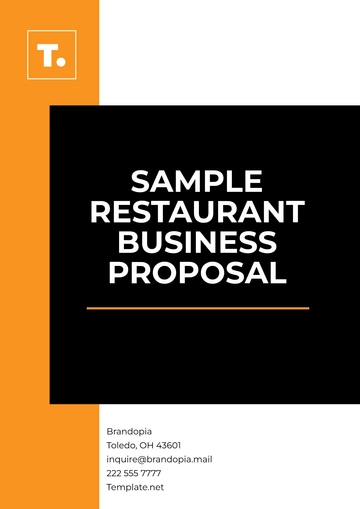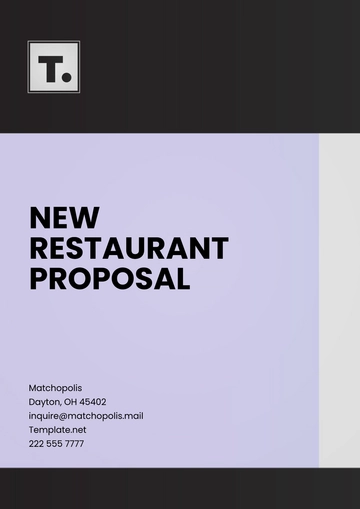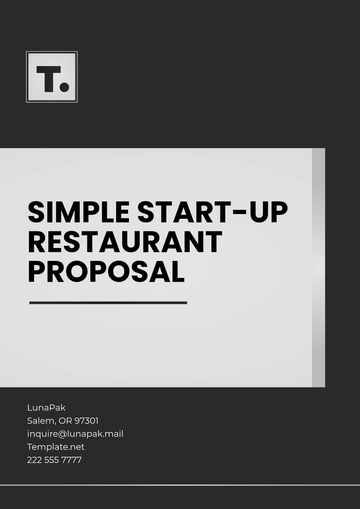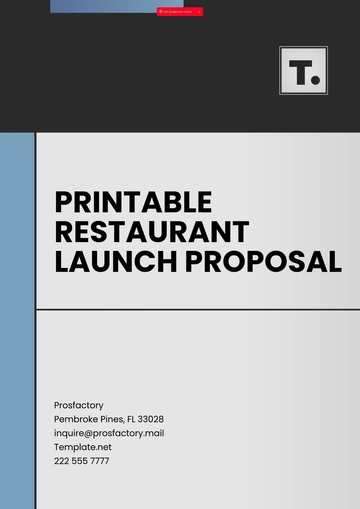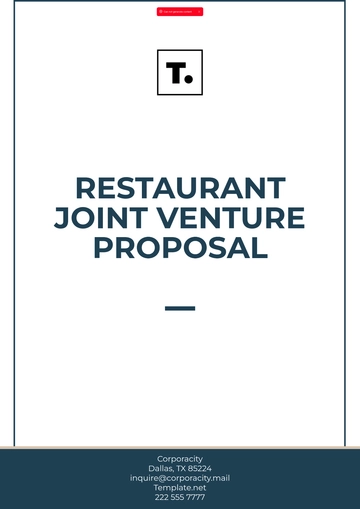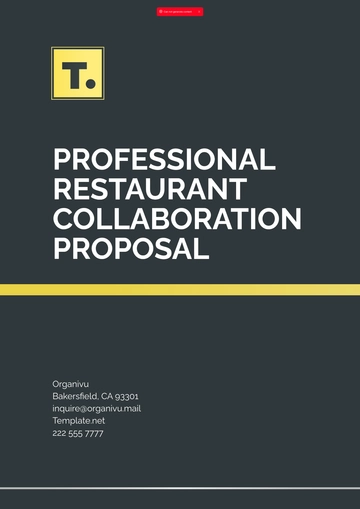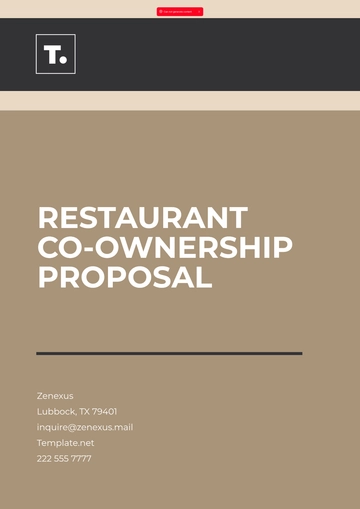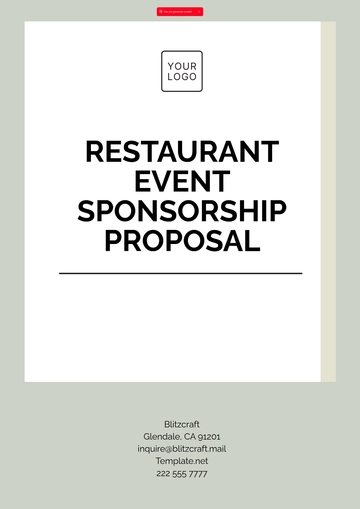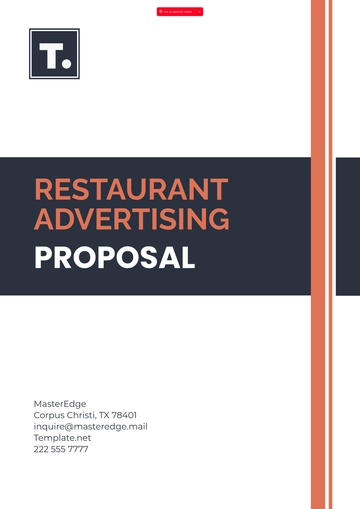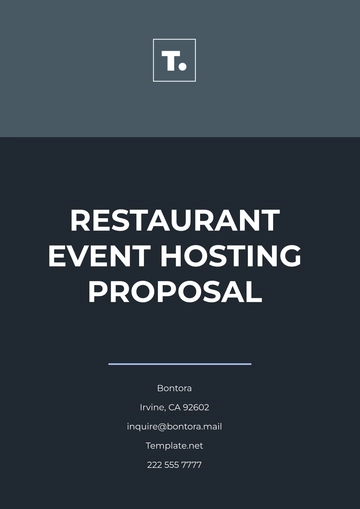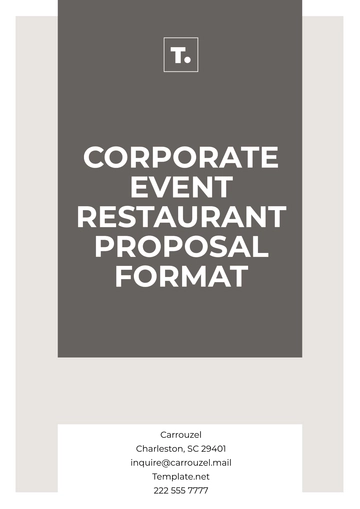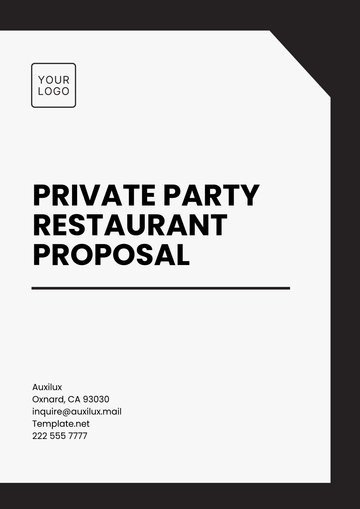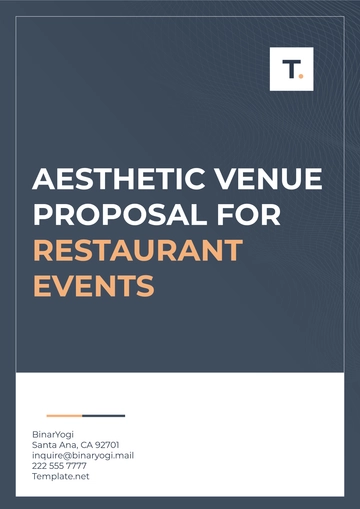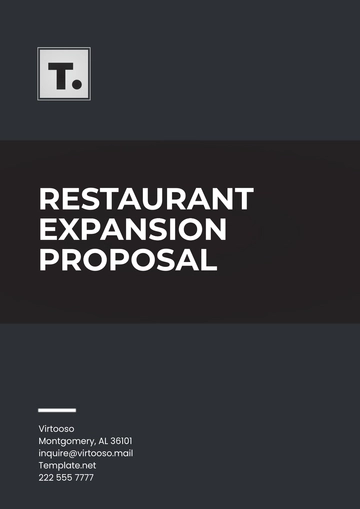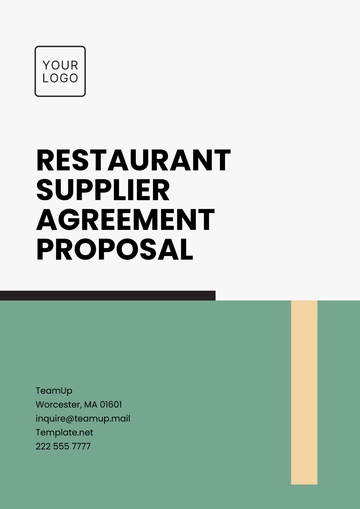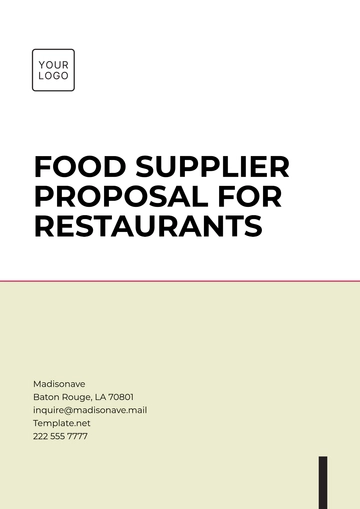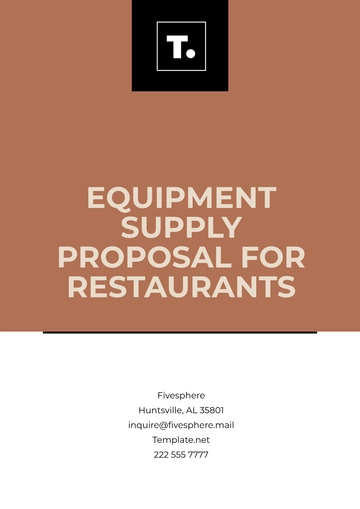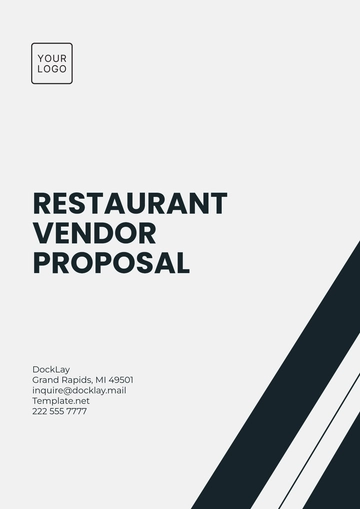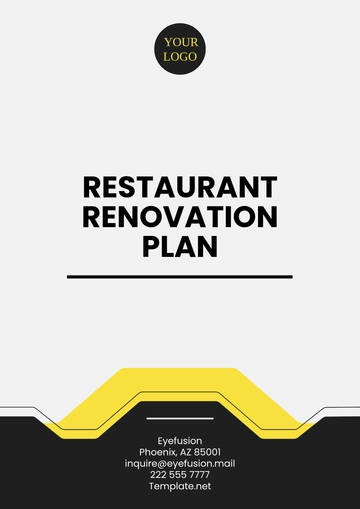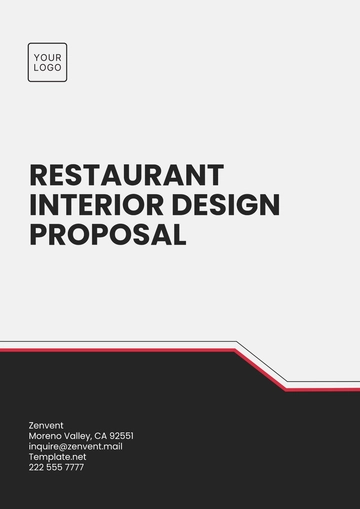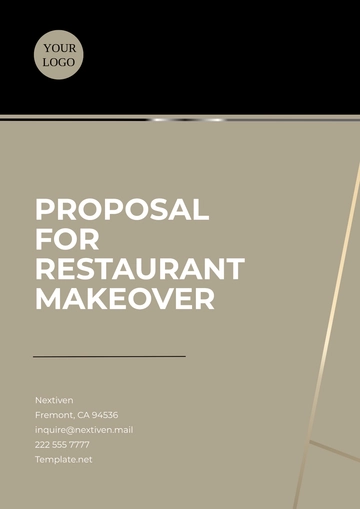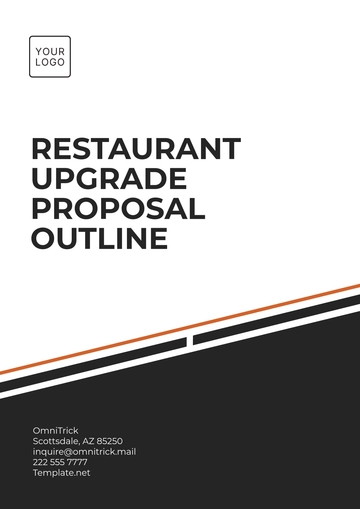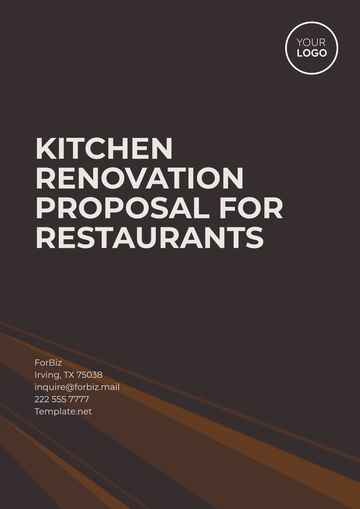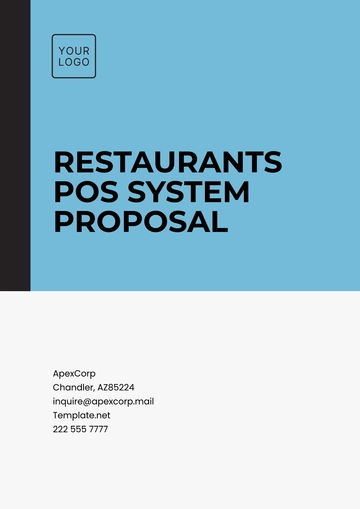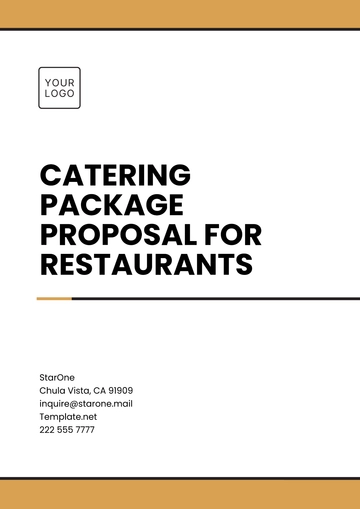Free Restaurant Expansion Proposal
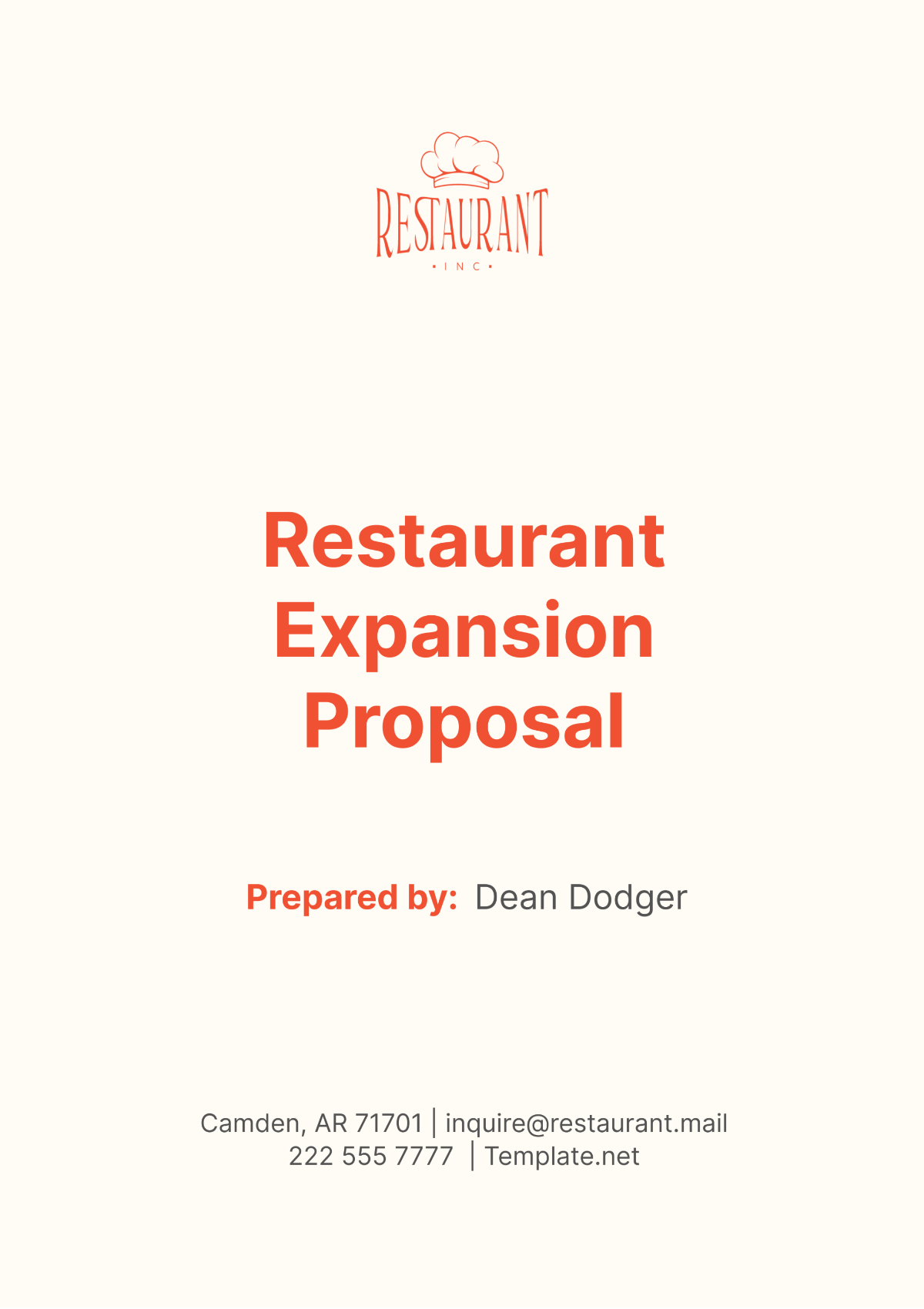
Prepared by: [Your Name]
Company: [Your Company Name]
Date: [Insert Date]
I. Executive Summary:
[Your Company Name], a renowned establishment offering a fusion of global flavors in a cozy and welcoming atmosphere, is excited to present this comprehensive proposal for expansion. With a decade of success in our current location and a strong reputation for culinary excellence and attentive service, we believe the time is right to embark on a strategic expansion initiative.
This proposal outlines our vision for growth, including the opening of a second location, menu enhancements, facility upgrades, and the implementation of a robust marketing strategy. Through this expansion, [Your Company Name] aims to elevate the dining experience for our valued customers and capture new market opportunities.
II. Business Overview:
[Your Company Name], established in [Year] by Chef [Founder's Name], has become a beloved culinary destination in the heart of [Location]. Our commitment to sourcing the finest ingredients, crafting innovative dishes, and providing exceptional hospitality has earned us a loyal following among locals and tourists alike. From signature dishes like our succulent Grilled Salmon with Lemon Herb Butter to decadent desserts such as the indulgent Molten Chocolate Lava Cake, every aspect of the dining experience at [Your Company Name] is crafted to delight the senses and leave a lasting impression.
III. Market Analysis:
The culinary landscape is an ever-evolving tapestry woven with the threads of diverse tastes, evolving preferences, and dynamic consumer behaviors. In this section, we delve deep into the market dynamics to unveil the rich opportunities and promising trends that underpin the strategic expansion of [Your Company Name].
A. Current Market Dynamics:
[Your Company Name] currently operates in a culinary landscape characterized by a vibrant mix of local eateries, upscale dining establishments, and international cuisine offerings. Our flagship location has thrived amidst this diversity, carving out a niche as a destination for discerning diners seeking a unique fusion of global flavors and unparalleled hospitality.
Key market dynamics shaping our current operating environment include:
Culinary Diversity: The culinary scene in [Current Location] is a mosaic of flavors, with restaurants showcasing cuisines from around the world. This diversity reflects the cosmopolitan nature of our city and the eclectic tastes of its residents and visitors.
Upscale Casual Dining Trend: There is a growing demand for upscale casual dining experiences, characterized by a balance of refined cuisine and relaxed ambiance. [Your Company Name] has successfully positioned itself within this segment, attracting patrons seeking elevated dining experiences without the formality of fine dining.
Local Sourcing and Sustainability: Increasingly, consumers are prioritizing sustainability and ethical sourcing when dining out. [Your Company Name]'s commitment to sourcing local, seasonal ingredients resonates with environmentally-conscious diners who value transparency and authenticity in their food choices.
B. Emerging Market Opportunities:
While our current market presents a fertile ground for culinary innovation, there are several emerging trends and opportunities that signal potential avenues for growth and expansion:
Millennial Dining Preferences: Millennials represent a significant portion of the dining demographic, with preferences shaped by factors such as social consciousness, adventurous palate, and desire for experiential dining. [Your Company Name] is well-positioned to appeal to this demographic segment, offering Instagram-worthy dishes, shareable plates, and immersive dining experiences.
Rise of Food Tourism: Food tourism has emerged as a burgeoning trend, with travelers increasingly seeking authentic culinary experiences as part of their itinerary. [Your Company Name] has the opportunity to capitalize on this trend by positioning itself as a must-visit destination for visitors seeking a taste of the local culinary scene.
Health and Wellness Focus: With growing awareness of health and wellness, there is a rising demand for nutritious yet flavorful dining options. [Your Company Name] can cater to this demand by expanding its menu to include healthier choices, such as plant-based dishes, whole grains, and lean proteins, without compromising on taste or quality.
C. Target Market Segmentation:
Understanding the diverse needs and preferences of our target market is essential for effective expansion planning. [Your Company Name] identifies the following key segments within our target demographic:
Urban Professionals: Young professionals and urban dwellers seeking upscale dining experiences characterized by innovative cuisine, stylish ambiance, and impeccable service.
Food Enthusiasts: Food aficionados and culinary enthusiasts passionate about exploring new flavors, cuisines, and dining concepts, who value authenticity and creativity in their dining experiences.
Family and Group Dining: Families, couples, and groups looking for memorable dining experiences to celebrate special occasions, socialize, and create lasting memories.
By segmenting our target market, [Your Company Name] can tailor its expansion strategy and offerings to meet the unique needs and preferences of each demographic segment, ensuring relevance and appeal across diverse consumer profiles.
D. Competitive Landscape:
Competition in the restaurant industry is fierce, with an array of dining options vying for consumers' attention and patronage. Key competitors in our market include:
Local Eateries and Cafés: Independent restaurants and cafés offering a range of cuisines and dining experiences, often characterized by a strong emphasis on local flavors and community engagement.
Upscale Dining Establishments: Fine dining restaurants and high-end eateries catering to a discerning clientele seeking luxurious dining experiences, gourmet cuisine, and refined ambiance.
International Cuisine Restaurants: Restaurants specializing in specific international cuisines, such as Italian, Japanese, or Mexican, offering authentic dishes and immersive dining experiences rooted in cultural heritage.
While competition is fierce, [Your Company Name] distinguishes itself through its unique blend of global flavors, commitment to quality and innovation, and personalized approach to hospitality, setting us apart as a leader in the upscale casual dining segment.
E. Regulatory and Compliance Considerations:
Navigating regulatory and compliance requirements is essential for successful expansion into new markets. [Your Company Name] will conduct thorough due diligence to ensure compliance with local regulations, licensing requirements, health and safety standards, and labor laws in the [New Location]. Additionally, we will proactively engage with local authorities, stakeholders, and community organizations to build positive relationships and foster goodwill within the community.
IV. Expansion Plan:
Our proposed expansion plan is multifaceted and includes the following key components:
Opening a Second Location: We plan to establish a second [Your Company Name] in the bustling neighborhood of [New Location]. This location was chosen for its high foot traffic, affluent demographics, and vibrant culinary scene. The new establishment will mirror the ambiance and menu offerings of our flagship location while catering to the unique preferences of the [New Location] community.
Menu Enhancements: In conjunction with our expansion, we will introduce exciting new additions to our menu, including seasonal specials, chef-inspired creations, and an expanded selection of vegetarian and vegan options. By continuously innovating and refining our menu offerings, we aim to delight our customers and keep them coming back for more.
Facility Upgrades: To ensure a seamless and enjoyable dining experience for our guests, we will invest in facility upgrades at both our existing and new locations. This includes renovations to modernize our interior décor, upgrade kitchen equipment for improved efficiency, and expand seating capacity to accommodate larger parties and private events.
V. Financial Projections:
The following financial projections are based on thorough analysis and market research:
Year | Revenue (USD) | Expenses (USD) | Net Profit (USD) |
|---|---|---|---|
Year 1 | $1,500,000 | $1,200,000 | $300,000 |
Year 2 | $1,800,000 | $1,350,000 | $450,000 |
Year 3 | $2,100,000 | $1,500,000 | $600,000 |
These projections are conservative estimates and are subject to market fluctuations and operational variables. Initial investment for the expansion is estimated at $800,000, which includes costs associated with leasing, renovations, equipment purchases, marketing, and staffing.
VI. Marketing Strategy:
Our marketing strategy is designed to generate buzz, drive traffic, and cultivate brand loyalty. Key initiatives include:
Social Media Engagement: We will leverage platforms such as Instagram, Facebook, and Twitter to showcase our new location, menu offerings, and behind-the-scenes glimpses of our culinary creations. Engaging content, including mouth-watering food photography and chef interviews, will help us connect with our audience on a personal level and build anticipation for the opening of our new establishment.
Local Partnerships: We will forge strategic partnerships with local businesses, influencers, and community organizations to increase our visibility and reach. Collaborative events, co-branded promotions, and sponsorships will help us tap into new customer segments and strengthen our ties to the community.
Digital Advertising: Targeted digital advertising campaigns will allow us to reach potential customers in the [New Location] area and drive traffic to our new establishment. Pay-per-click (PPC) ads, social media promotions, and geotargeted messaging will be tailored to appeal to the preferences and demographics of our target audience, maximizing the effectiveness of our marketing efforts.
VII. Operational Plan:
Our operational plan is designed to ensure seamless execution and optimal performance across all facets of our business. Key initiatives include:
Staffing and Training: We will recruit and train a skilled team of chefs, servers, bartenders, and support staff to deliver the highest levels of service and hospitality. Ongoing training programs will focus on product knowledge, guest interaction, and operational best practices, empowering our team members to excel in their roles and provide an exceptional dining experience for our guests.
Inventory Management: Efficient inventory management systems will be implemented to minimize waste, optimize purchasing decisions, and maintain consistent product availability. Regular inventory audits and vendor evaluations will help us streamline operations and control costs, ensuring that we are able to meet customer demand while maximizing profitability.
Customer Feedback Loop: We will establish a robust feedback loop to solicit input from our customers and incorporate their suggestions into our operations. Online surveys, comment cards, and social media monitoring will provide valuable insights into guest satisfaction and areas for improvement, allowing us to continuously refine and enhance the [Your Company Name] experience.
VIII. Risk Assessment:
While we are confident in the potential success of our expansion, we recognize the inherent risks associated with any business endeavor. Key risks include:
Market Saturation: The restaurant industry is highly competitive, and saturation in the market could impact our ability to attract and retain customers. To mitigate this risk, we will differentiate ourselves through unique menu offerings, exceptional service, and a distinct brand identity that resonates with our target audience.
Economic Uncertainty: Economic downturns or fluctuations in consumer spending could adversely affect our revenue and profitability. To safeguard against economic uncertainty, we will maintain a conservative financial approach, closely monitor market trends, and implement cost-saving measures where necessary to ensure the long-term viability of our business.
Operational Challenges: Managing multiple locations presents logistical challenges, including staffing, supply chain management, and quality control. To address these challenges, we will invest in robust operational systems and processes, implement rigorous training programs for our team members, and establish clear communication channels to facilitate seamless coordination between our two locations.
By proactively identifying and addressing potential risks, we aim to minimize their impact on our business and position [Your Company Name] for sustainable growth and success in the years to come.
IX. Conclusion
In conclusion, the proposed expansion of [Your Company Name] represents an exciting opportunity to build upon our success and further solidify our position as a leader in the upscale casual dining segment. With a clear vision, robust plan, and unwavering commitment to excellence, we are confident that our expansion will yield positive results for our business and create unforgettable experiences for our guests.
- 100% Customizable, free editor
- Access 1 Million+ Templates, photo’s & graphics
- Download or share as a template
- Click and replace photos, graphics, text, backgrounds
- Resize, crop, AI write & more
- Access advanced editor
Propose growth confidently with Template.net's Restaurant Expansion Proposal Template. Editable in our AI Editor Tool, this customizable template ensures clarity and professionalism in your proposals. Crafted for impact and feasibility, it streamlines your expansion plans, covering market analysis, financial projections, and operational strategies. Elevate your restaurant's growth potential with ease!
You may also like
- Business Proposal
- Research Proposal
- Proposal Request
- Project Proposal
- Grant Proposal
- Photography Proposal
- Job Proposal
- Budget Proposal
- Marketing Proposal
- Branding Proposal
- Advertising Proposal
- Sales Proposal
- Startup Proposal
- Event Proposal
- Creative Proposal
- Restaurant Proposal
- Blank Proposal
- One Page Proposal
- Proposal Report
- IT Proposal
- Non Profit Proposal
- Training Proposal
- Construction Proposal
- School Proposal
- Cleaning Proposal
- Contract Proposal
- HR Proposal
- Travel Agency Proposal
- Small Business Proposal
- Investment Proposal
- Bid Proposal
- Retail Business Proposal
- Sponsorship Proposal
- Academic Proposal
- Partnership Proposal
- Work Proposal
- Agency Proposal
- University Proposal
- Accounting Proposal
- Real Estate Proposal
- Hotel Proposal
- Product Proposal
- Advertising Agency Proposal
- Development Proposal
- Loan Proposal
- Website Proposal
- Nursing Home Proposal
- Financial Proposal
- Salon Proposal
- Freelancer Proposal
- Funding Proposal
- Work from Home Proposal
- Company Proposal
- Consulting Proposal
- Educational Proposal
- Construction Bid Proposal
- Interior Design Proposal
- New Product Proposal
- Sports Proposal
- Corporate Proposal
- Food Proposal
- Property Proposal
- Maintenance Proposal
- Purchase Proposal
- Rental Proposal
- Recruitment Proposal
- Social Media Proposal
- Travel Proposal
- Trip Proposal
- Software Proposal
- Conference Proposal
- Graphic Design Proposal
- Law Firm Proposal
- Medical Proposal
- Music Proposal
- Pricing Proposal
- SEO Proposal
- Strategy Proposal
- Technical Proposal
- Coaching Proposal
- Ecommerce Proposal
- Fundraising Proposal
- Landscaping Proposal
- Charity Proposal
- Contractor Proposal
- Exhibition Proposal
- Art Proposal
- Mobile Proposal
- Equipment Proposal
- Student Proposal
- Engineering Proposal
- Business Proposal

